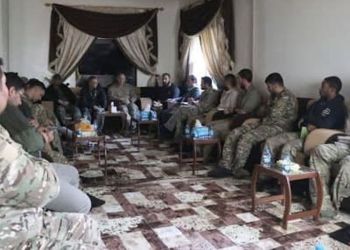This post is also available in:
![]() العربية
العربية
Deir Ezzor 24- Opinion Article
Tension has blown the area since the killing of Sheikh Muttashar al-Hafal and his escort in August and repercussions of killing a dignitary of the area. Tensions stirred inquiries about movement of society in Deir Ezzor tribal countryside whose social structure is different from other Syrian areas.
Unstable security situation prevailed in the area since the International Coalition and its local partners in Syrian Democratic Forces (SDF) liberated the al-Baghouz, and controlled areas in Deir Ezzor east of the Euphrates. Systematic assassinations mostly bearing Daesh signs occurred in the area as Daesh groups are active in Deir Ezzor countryside under the cover of insecurity, which neither the International Coalition nor the SDF put an end to. Insecurity poses serious worry about the International Coalition and SDF’ seriousness in sustaining stability in the area.
New assassination attempt tolls danger bells:
On October 7, 2020, masked shooters on motorcycles attempted to assassinate Amlah Muheisen al-Abdulaziz, who is a tribal dignitary of the area and a major member of the local council of the town of Ash-Shaheil. Bearing Daesh signs, the shooters used pistols and k47 rifles. Al-Abdulaziz was injured in the hand and abdomen as he was moving around his house.
The assassination attempt reminds us of the scenario in August when tribal dignitaries were assassinated, in addition to failed assassination attempts. Though such operations should have set a different military and security perspective in an attempt for the scenario not to repeat, the matter backfired as the SDF removed security checkpoints from the perimeter of the areas where the assassination attempt occurred. Though no one can know the real and logical reason for removing the checkpoints in this time, what encouraged the perpetrators was the removal of the checkpoints.
The SDF and the International Coalition and the United States from behind are not aware or unwilling to be aware of the characteristics of the tribal area in which sustaining security would balance this fact and the fact saying that the area could be safe and this is not impossible.
When we mention the SDF and the Deir Ezzor civil or military council, we experience the state of pre-institutionalism, i.e., a state vulnerable to security breaches, or it could already be infiltrated by the Assad regime, Iran, and even Daesh, though with varied degrees.
The message:
Shots are the best way of delivering a message for all parties in the area. Such a message implies the solution. The recent assassination attempt will not be the last unless the forces controlling east of the Euphrates try to work seriously to save the area first by sustaining security and cooperating with the people of the area, dividing the area into sectors so that people contribute to protecting their areas, sustaining safety in the area by implementing economic projects and rehabilitating devastated infrastructure, otherwise what is the explanation of weakness of developmental, services, and infrastructure projects in an area rich with oil and gas.
It seems that the SDF and International Coalition are not serious about Iran’s and Assad’s attempts to infiltrate the area east of the Euphrates. Iran will not miss the chance to control the area, especially with the feeling that the SDF and International Coalition do not establish a long-term strategy to remain in the area at least in holding direct meetings with people and providing real guarantees to sustain stability and security in the area amidst Iran’s, Assad’s, and Daesh threats. The International Coalition-led operations are limited targeting Daesh; however, at the same time, Iran’s, Assad’s, and even Daesh’s groups are still active. Could it all be a complex algorithm?
A year ago, events proved the US can turn its back to the area even if it established a thousand military bases. This exactly happened a year ago during the Turkish invasion of areas controlled by the US allies. Events also proved that the SDF and its major Kurdish component in particular can turn its back to Deir Ezzor at any moment even if the SDF opened a thousand civil and administrative offices. This exactly happened a year ago in the same context of the US withdrawal decision as headed to the Ras al-Ayn, Tall-Tamr, and other areas. The entire area was at risk, as the expected scenario was likely to be leaving the people of Deir Ezzor a prey for those who seek retaliation against the people who refused to subject to them. Such category that includes the Syrian regime, Russia, Iranian militias, and Daesh are the worst in Syria. None of these parties is good to the people of the area.
In this stage and before the worst happens, the International Coalition and SDF should be serious about sustaining security and caring for the area so that it flourishes away from abhorrent Pragmatism that will not establish a long-term strategy of remaining in the area.
By Omar Abu Layla, Deir Ezzor 24 executive director











